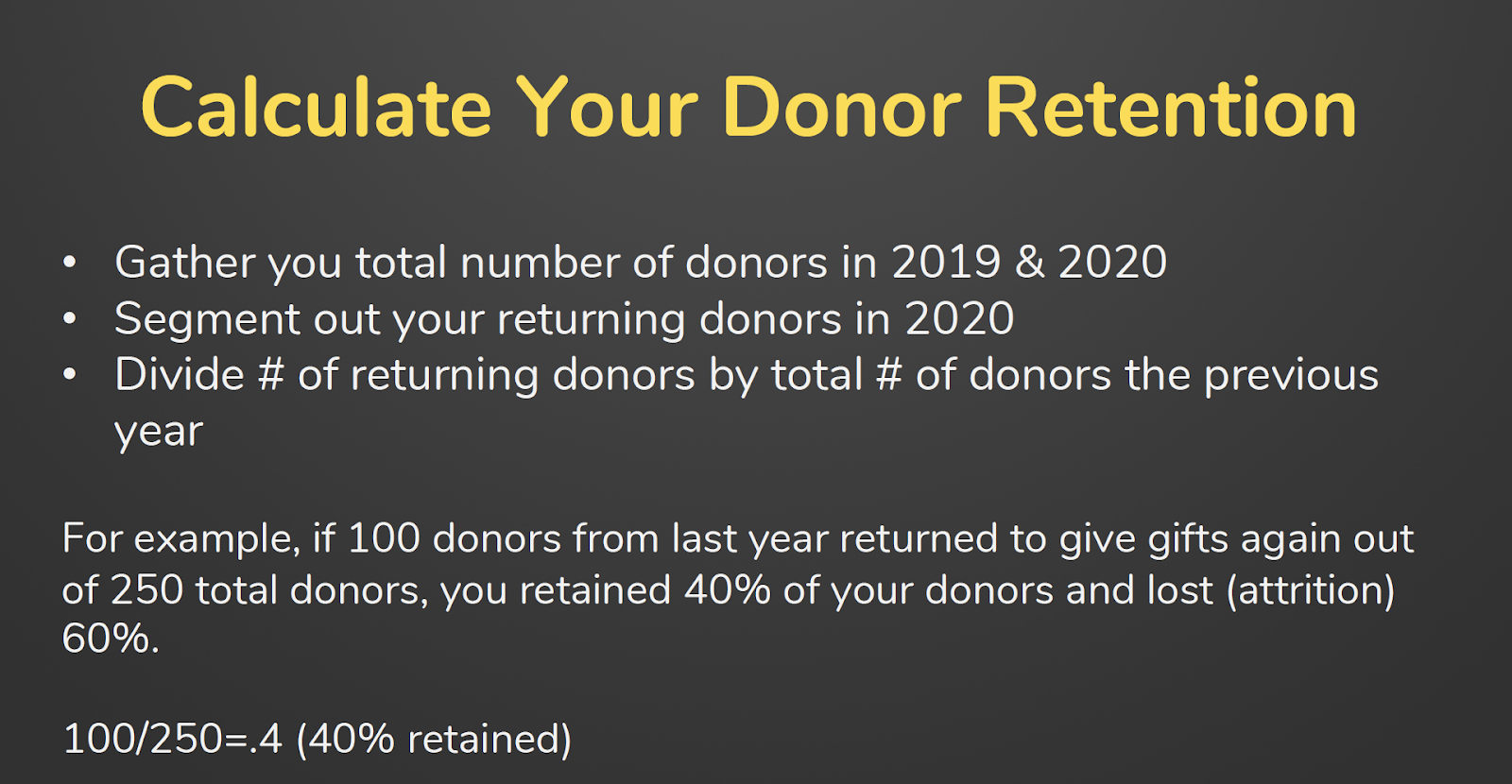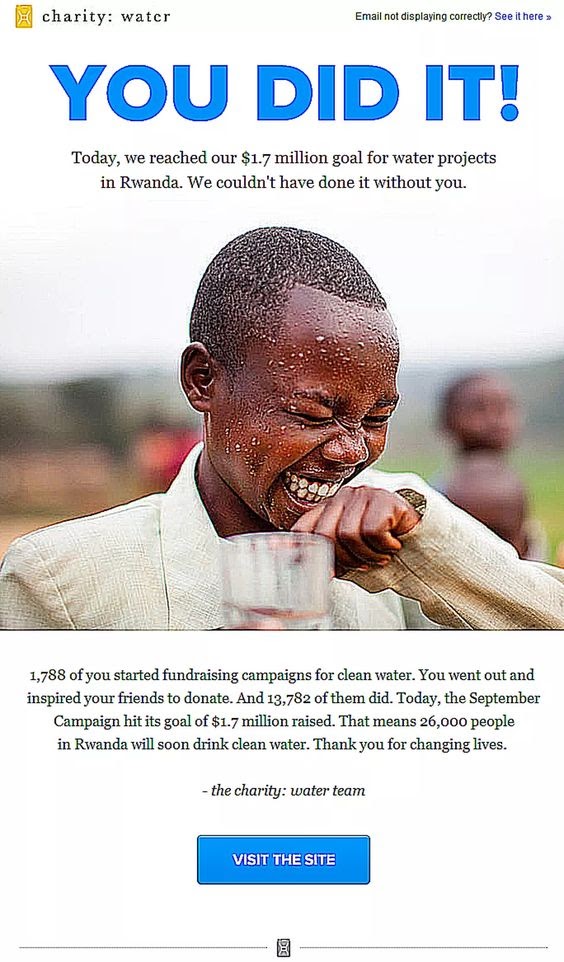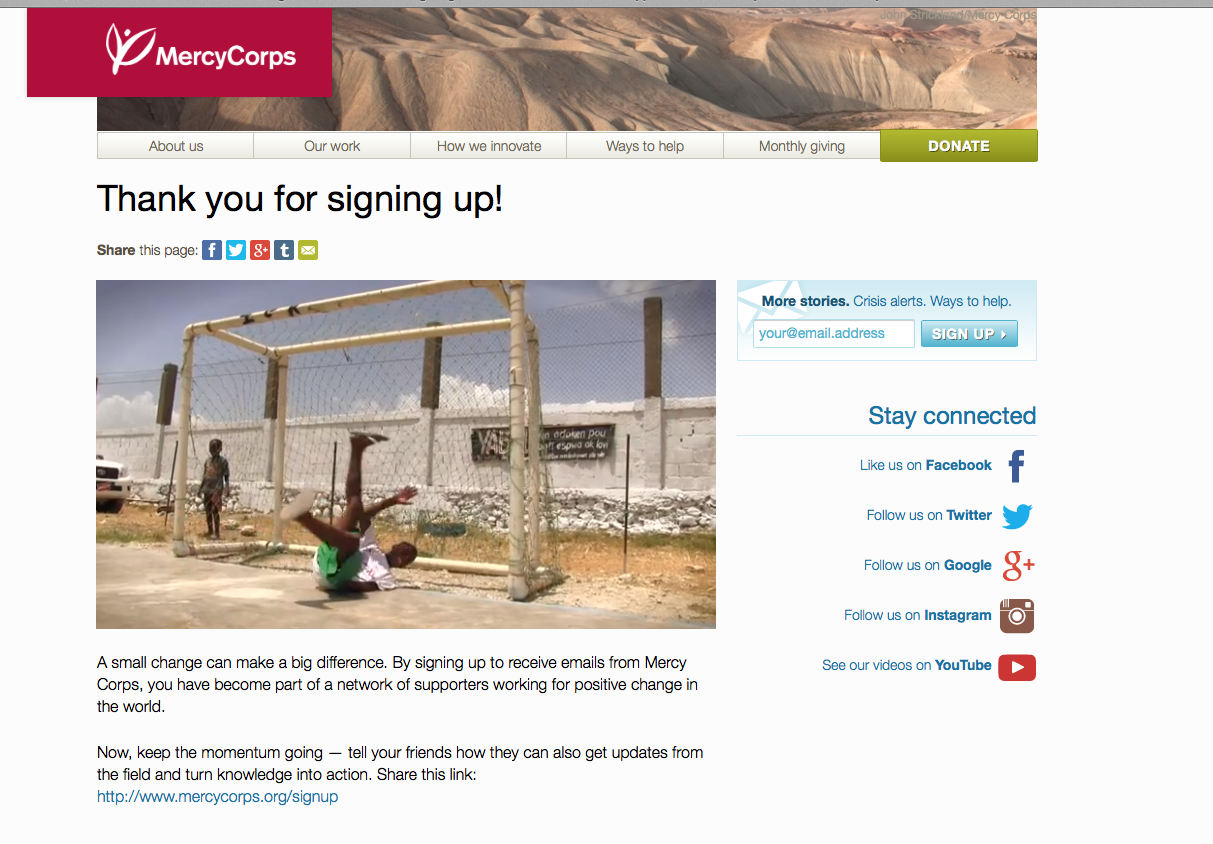We’ve made it through 2020, and with it the final push for year-end donations. This is the point where most fundraisers breathe a big sigh of relief and take a moment to relax. But don’t chill out just yet: you still want to make sure that your organization retains those year-end donors from 2020.
This is the perfect time to begin your stewardship plan so that you end up with fantastic donor retention.

You might be asking why you need to put a ton of time and energy into bringing your donors back for a second donation. It’s a simple formula: attracting new donors costs a lot more than getting previous donors to give again.
You’re saving money by improving your donor retention. You’re also more likely to get larger gifts from donors who give over time, so you’re making more money.

The second piece of the equation is that honestly your current donor retention probably sucks. I know it’s tough to hear, but the average nonprofit loses 60% of its donors each year. That’s tons of money that you’re losing.

And 2020 was not a great year for new donor retention: it dropped almost 8%. That means that 2021 is the perfect year to come back strong and build a great donor retention plan to help you retain your year-end donors. Ready? Let’s make this happen.
What is Donor Retention?
You’re probably generally familiar with the concept of donor retention, but you may not know your own rate or the many nuances of retention. Very simply, donor retention refers to the number (or percentage) of donors that return to give another gift in a specific time period. Most nonprofits and charities measure donor retention year over year.

A great place to start is by calculating your own donor retention. That will let you know your base level and help you take data as you move forward to see which strategies work for your donors. All you have to do is divide the number of returning donors you had in 2020 by the number of total donors from 2019.
You can go even further than that simple calculation though. You can also look at the number of first time donors from 2019 who gave a second gift in 2020 (your first-time donor retention rate). Or you can sort out those who are returning donors. On average, 19% of first-time donors give another gift while 63% of returning donors give again.
Other figures to look at are the average annual gift (if it goes up or down over time), the lifetime value of an average donor, and your donor acquisition costs.
Now that you’ve got some data, what can you do to improve your donor retention rates?
1. The Art Of The Thank You
The first piece in any donor retention strategy (especially one for retaining year-end donors) is the thank you. This is the first interaction your donor will have with the organization after they make their donation. That means it’s pretty important.
If you want to learn more about thanking donors to increase retention, check out our webinar on writing perfect donor thank yous.

Beyond your generic thank you email that likely doubles as a donation receipt, now is also a fantastic time to have a more personal contact.
Charity: water has always been stellar at thank yous, and this email is a great example. The photo is engaging, the headline tells the reader what they’ve done, and it gives exact numbers of the impact of the donation.
Take this first week of the new year to send a message (email, direct mail or phone) specifically to your new donor. Introduce yourself, thank them for their gift, and ask them to connect in another way such as subscribing to your email newsletter or “Liking” your organization’s Facebook page. This is especially important for first-time donors because it gets them to engage with your organization another time, cementing the relationship.

MercyCorps gives a great example of asking donors to take another step by suggesting they share with their friends.
2. Segmenting Your Year-End Donors
Once you’ve thanked your donors it’s time to start building an ongoing strategy to make them into lifelong supporters. The best way to do this is segmentation, which essentially means breaking up your donors based on similar traits. Was it because they saw their friend’s peer-to-peer fundraising post on social media? Were they forwarded a link through email from one of your clients? Did they happen to stumble across your donation page through an online search?
Use your donation software such as a CSM or even a spreadsheet to track and monitor this essential donor data. If you captured any other pertinent data during the donation process, be sure to document this as well.
From here you can start to build specific lists of different types of donors.
Segmenting your donors is important because it helps you to tailor your communications to the donors. If you have a group of high-end donors who give large amounts at the end of each year, you’ll want to approach them differently than a group of new donors who each gave $10. Think about how you can personalize your stewardship to each group.
Your next email or connection will then vary based on segmentation. Donors who gave $1000 or more may receive a personal phone call to learn about their interests, while $10 donors may get a welcome email series (don’t worry, we’ll talk more about that soon).
This is also a good time to start learning more about your donors. You may ask them to sign up for an email list, or fill out a short survey to tell you more information about themselves. Everything you know helps you build a picture of your donor.
Download CauseVox’s Donor Engagement & Retention Playbook:
[amp-optin id=44143]
3. Build A Relationship To Retain Your Year-End Donors
Now that you have an idea of who your donors are, it’s time to start sharing who you are with them. Within the first 30 days of the year, it’s a good idea to share some stories about your organization with these new donors. Share why your organization is involved in your line of work and how your donor plays a role in that success. They can come through any channel: email, direct mail, social media. Whatever feels comfortable.
The best way to cement that relationship is by asking your donor to engage with you one more time. Give your donor the opportunity to do something that will positively impact your organization and help form a strong bond between your donor and your cause.
There are tons of options for this. Here are a few examples:
- Ask them to share your social media posts on their personal pages
- Send out a donor survey to get more information about your donor, including their affinities, preferred communication styles, and their desire/ability to volunteer.
- Ask them to sign up for a newsletter
- Invite them to an event
Whatever action they take, it will give them a deeper connection to your organization.
4. Year-End Donor Retention Tips and Tricks
Ok, all of that was a lot of information and you came here for a quick and easy list to follow right? Well we’ve got it for you! Here are the best ways to ensure your donors come back for a second gift.
1. Thank Your Donors Within 48 Hours
We already said it but we’ll say it again because the thank you is so important. Get it to your donor quickly so that they know you’re paying attention.
2. Ask For The Second Donation Within 90 Days
Remember what we said about how much higher returning donor retention rates are? What that means is that if you can get your donor to give again, they’re more likely to keep on giving. According to Bloomerang, donors who give a second gift within the first three months of their first give nearly twice as much over a five-year period. Use that honeymoon period to your advantage!
3. Create An Email Nurture Series
According to a study by the Charities Aid Foundation, 68% of donors agree that knowing how their gift made an impact is important to them. Not only that, but most experts suggest it takes between 7 and 12 touches for a donor to decide to make another donation.
A great way to keep in touch with your donors and prep them for their next donation is with an email welcome series. This is where you introduce your new donors to your organization, communicate impact, get them even more involved in your work, and convert them into lifelong super advocates.
4. Increase Engagement!
Every time your donor takes an action to connect with your organization, it strengthens your relationship. That means you can build your donor loyalty without asking for another donation. Consider asking them to sign up for a newsletter, follow you on social media, or volunteer at one of your events. You can go above and beyond by hosting donor-centric events like appreciation luncheons (or Zoom calls).
5. Educate Your Donors
Keep donors informed about WHY their gift matters.
- Share nonprofit stories about those impacted by your organization’s work
- Use powerful images and videos to educate your social media followers
- Include information in your communications that is relevant and useful for your supporters. If your donor thinks your content is of use, they’re more likely to share it with others.
This also means sharing the results of your work. There are many ways to report results to supporters, including:
- Impact reports
- Newsletters
- Annual Report
- Infographics and statistics shared on social media and email
Increase Donor Engagement and Retention With Less Effort On CauseVox
Need a solution to help you implement these donor engagement and retention best practices?
CauseVox is a digital fundraising platform for nonprofits that helps you raise more with less effort through our fundraising software.
Typical fundraising software is clunky, complex, and contract-bound, but CauseVox actually tidies up your digital fundraising. Run donation pages, crowdfunding, and peer to peer fundraising in less time, without hassle.




